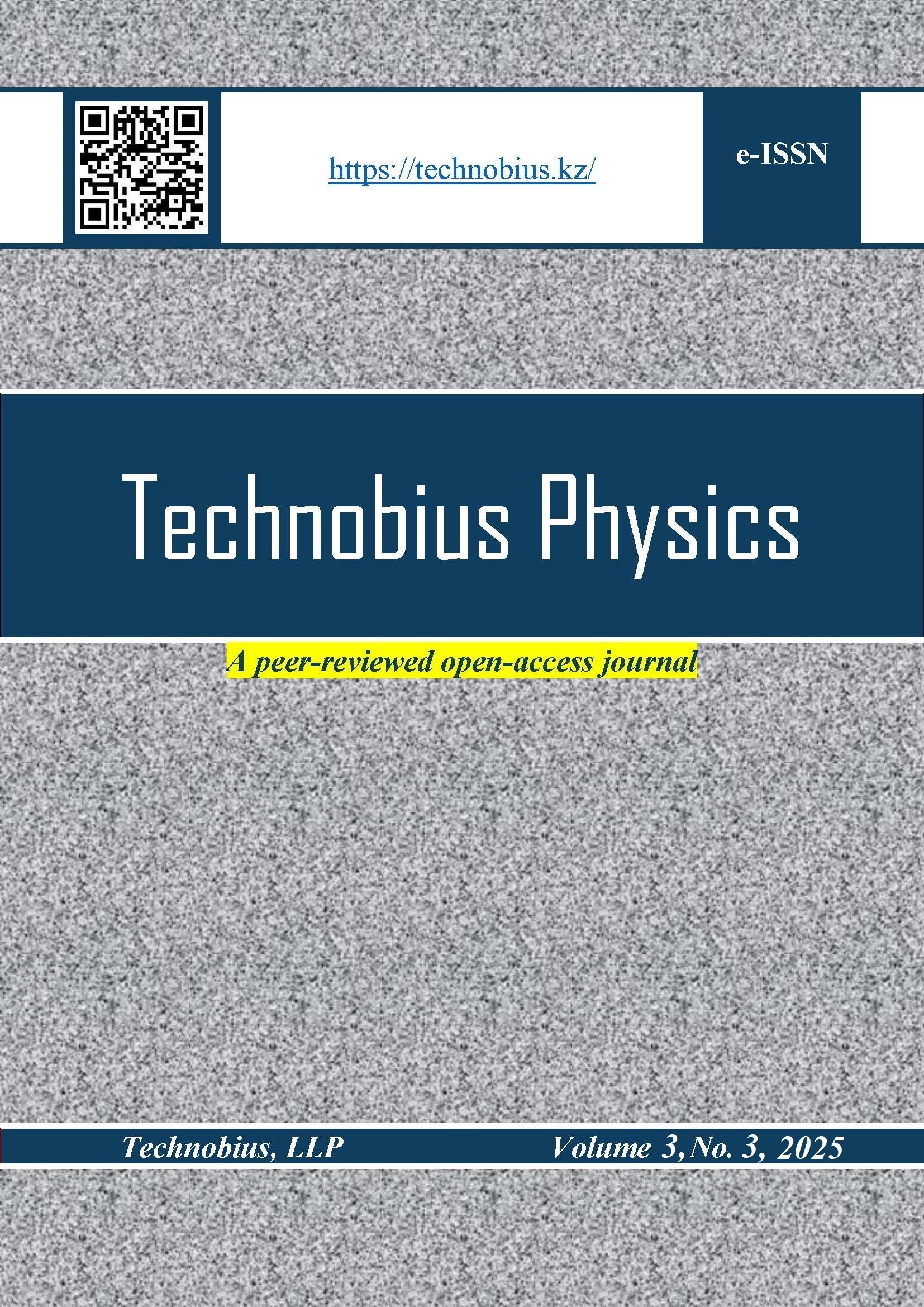Numerical framework for simulating quantum spacetime fluctuations with prescribed spectra
DOI:
https://doi.org/10.54355/tbusphys/3.3.2025.0038Keywords:
quantum spacetime fluctuations, stochastic modeling, power spectrum, spatial correlation, temporal autocorrelation, Gaussian statistics, Planck-scale dynamicsAbstract
Understanding quantum fluctuations of spacetime at the Planck scale remains one of the central challenges of theoretical physics. This study introduces a stochastic framework to model such fluctuations, aiming to test whether a phenomenological approach can reproduce expected statistical signatures of quantum geometry. The metric field was represented as a one-dimensional Gaussian process with a prescribed power spectrum, and its Fourier modes were evolved through an Ornstein–Uhlenbeck process to enforce stationarity. Numerical simulations were carried out on a discretized domain with periodic boundary conditions, and statistical analyses were performed on power spectra, spatial correlations, temporal autocorrelations, and field distributions. The results showed that the empirical power spectrum reproduced the target distribution across more than two decades in wavenumber, with a clear suppression of high-frequency modes due to ultraviolet damping. The spatial correlation function indicated a coherence scale of approximately 150–200 Planck lengths, beyond which fluctuations decorrelate, making spacetime effectively smooth at larger scales. Temporal autocorrelations decayed exponentially with a relaxation time of about 200 Planck units, demonstrating that spacetime fluctuations possess finite memory. The field amplitudes followed a Gaussian distribution, supporting the assumption of central-limit behavior in the linear regime. Stationary field snapshots confirmed equilibrium behavior throughout the simulation. Overall, the study establishes a reproducible and computationally efficient framework for simulating Planck-scale metric fluctuations. The findings highlight short correlation lengths, finite coherence times, and Gaussian statistics as key features of quantum spacetime, providing a bridge between phenomenological modeling and fundamental theory.
Downloads
Metrics
References
T. Padmanabhan, S. Chakraborty, and D. Kothawala, “Spacetime with zero point length is two-dimensional at the Planck scale,” Gen. Relativ. Gravit., vol. 48, no. 5, May 2016, doi: 10.1007/s10714-016-2053-2.
J. M. García-Islas, “Quantum geometry ii: The mathematics of loop quantum gravity—three-dimensional quantum gravity,” Can. J. Phys., vol. 99, no. 8, pp. 601–606, 2021, doi: 10.1139/cjp-2020-0423.
M. A. Anacleto, C. H. G. Bessa, F. A. Brito, A. E. Mateus, E. Passos, and J. R. L. Santos, “LIV effects on the quantum stochastic motion in an acoustic FRW-geometry,” Eur. Phys. J. C, vol. 82, no. 4, Apr. 2022, doi: 10.1140/epjc/s10052-022-10303-2.
Y. Ling, M. H. Wu, and Y. Xiao, “Entanglement in simple spin networks with a boundary,” Chinese Phys. C, vol. 43, no. 1, Jan. 2019, doi: 10.1088/1674-1137/43/1/013106.
J. Williams, A. Rotti, and R. Battye, “Constraining cosmic polarization rotation and implications for primordial B-modes,” J. Cosmol. Astropart. Phys., vol. 2020, no. 9, Sep. 2020, doi: 10.1088/1475-7516/2020/09/006.
H. L. Zhen, Y. Z. Du, H. F. Li, L. C. Zhang, and Y. B. Ma, “Higher-dimensional topological dS black hole with a nonlinear source and its thermodynamics and phase transitions,” Eur. Phys. J. C, vol. 84, no. 7, Jul. 2024, doi: 10.1140/epjc/s10052-024-13085-x.
J. Barenboim, A. V. Frolov, and G. Kunstatter, “No drama in two-dimensional black hole evaporation,” Phys. Rev. Res., vol. 6, no. 3, Jul. 2024, doi: 10.1103/PhysRevResearch.6.L032055.
M. Leetmaa and N. V. Skorodumova, “KMCLib 1.1: Extended random number support and technical updates to the KMCLib general framework for kinetic Monte-Carlo simulations,” Comput. Phys. Commun., vol. 196, pp. 611–613, Nov. 2015, doi: 10.1016/j.cpc.2015.06.016.
Y. Han and D. Zhang, “Modified trajectory fitting estimators for multi-regime threshold Ornstein–Uhlenbeck processes,” Stat, vol. 12, no. 1, Jan. 2023, doi: 10.1002/sta4.620.
H. Yuan and Q. Zhu, “Some stabilities of stochastic differential equations with delay in the G-framework and Euler–Maruyama method,” J. Comput. Appl. Math., vol. 446, Aug. 2024, doi: 10.1016/j.cam.2024.115856.
T. S. Gau, P. H. Chen, B. J. Lin, F. H. Ko, C. K. Chen, and A. Yen, “Ultra-fast aerial image simulation algorithm using wavelength scaling and fast Fourier transformation to speed up calculation by more than three orders of magnitude,” J. Micro/Nanopatterning, Mater. Metrol., vol. 22, no. 2, Apr. 2023, doi: 10.1117/1.JMM.22.2.023201.
A. Bonanno, “On the structure of the vacuum in quantum gravity: A view from the asymptotic safety scenario,” Universe, vol. 5, no. 8, Aug. 2019, doi: 10.3390/universe5080182.
H. Gao, L. Xiao, K. Wang, D. Qu, Q. Lin, and P. Xue, “Experimental verification of trade-off relation for coherence and disturbance,” New J. Phys., vol. 24, no. 7, Jul. 2022, doi: 10.1088/1367-2630/ac7c2c.
A. Kogut et al., “The Primordial Inflation Explorer (PIXIE): mission design and science goals,” J. Cosmol. Astropart. Phys., vol. 2025, no. 4, Apr. 2025, doi: 10.1088/1475-7516/2025/04/020.
G. M. Zinovjev and S. V. Molodtsov, “Four-fermion interaction in relativistic heavy ion collisions,” Phys. Part. Nucl., vol. 44, no. 3, pp. 577–622, May 2013, doi: 10.1134/S1063779613030180.
A. Götz, G. Rein, J. C. Inácio, and F. F. Assaad, “Hubbard and Heisenberg models on hyperbolic lattices: Metal-insulator transitions, global antiferromagnetism, and enhanced boundary fluctuations,” Phys. Rev. B, vol. 110, no. 23, Dec. 2024, doi: 10.1103/PhysRevB.110.235105.
L. Warszawski and A. Melatos, “Gravitational-wave bursts and stochastic background from superfluid vortex avalanches during pulsar glitches,” Mon. Not. R. Astron. Soc., vol. 423, no. 3, pp. 2058–2074, 2012, doi: 10.1111/j.1365-2966.2012.20977.x.
T. Stuttard, “Neutrino signals of lightcone fluctuations resulting from fluctuating spacetime,” Phys. Rev. D, vol. 104, no. 5, Sep. 2021, doi: 10.1103/PhysRevD.104.056007.
Downloads
Published
How to Cite
License
Copyright (c) 2025 Do-Yoon Lee, Gye-Tai Park

This work is licensed under a Creative Commons Attribution-NonCommercial 4.0 International License.








